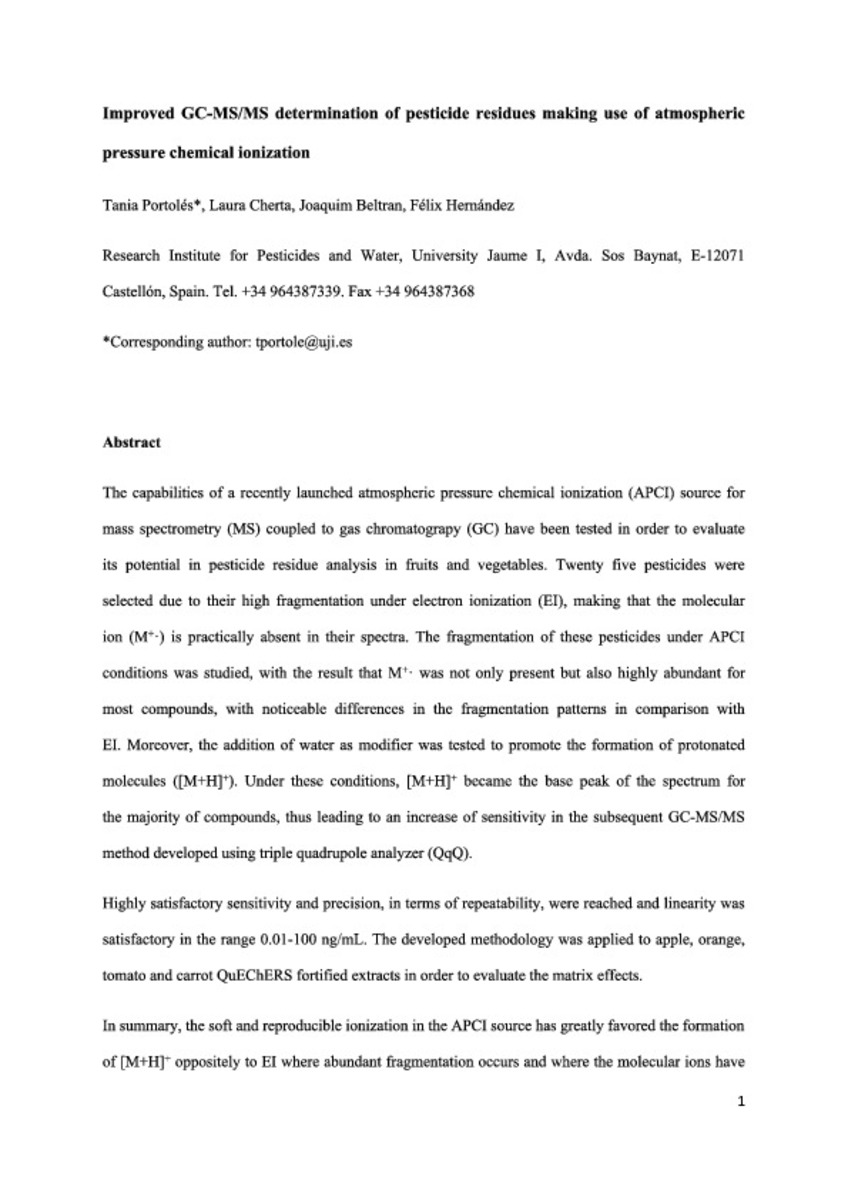Mostrar el registro sencillo del ítem
Improved gas chromatography–tandem mass spectrometry determination of pesticide residues making use of atmospheric pressure chemical ionization
| dc.contributor.author | Hernandez, Felix | |
| dc.contributor.author | Beltran Arandes, Joaquin | |
| dc.contributor.author | Portoles, Tania | |
| dc.contributor.author | Cherta Cucala, Laura | |
| dc.date.accessioned | 2013-05-10T13:48:10Z | |
| dc.date.available | 2013-05-10T13:48:10Z | |
| dc.date.issued | 2012 | |
| dc.identifier.citation | Journal of Chromatography A Volume 1260, 19 October 2012, Pages 183–192 | ca_CA |
| dc.identifier.issn | 0021-9673 | |
| dc.identifier.issn | 1873-3778 | |
| dc.identifier.uri | http://hdl.handle.net/10234/63135 | |
| dc.description.abstract | The capabilities of a recently launched atmospheric pressure chemical ionization (APCI) source for mass spectrometry (MS) coupled to gas chromatography (GC) have been tested in order to evaluate its potential in pesticide residue analysis in fruits and vegetables. Twenty-five pesticides were selected due to their high fragmentation under electron ionization (EI), making that the molecular ion (M+) is practically absent in their spectra. The fragmentation of these pesticides under APCI conditions was studied, with the result that M+ was not only present but also highly abundant for most compounds, with noticeable differences in the fragmentation patterns in comparison with EI. Moreover, the addition of water as modifier was tested to promote the formation of protonated molecules ([M+H]+). Under these conditions, [M+H]+ became the base peak of the spectrum for the majority of compounds, thus leading to an increase of sensitivity in the subsequent GC–MS/MS method developed using triple quadrupole analyzer (QqQ). Highly satisfactory sensitivity and precision, in terms of repeatability, were reached and linearity was satisfactory in the range 0.01–100 ng/mL. The developed methodology was applied to apple, orange, tomato and carrot QuEChERS fortified extracts in order to evaluate the matrix effects. In summary, the soft and reproducible ionization in the APCI source has greatly favored the formation of [M+H]+ oppositely to EI where abundant fragmentation occurs and where the molecular ions have low abundance or are even absent in the mass spectrum. In this way, the use of APCI has facilitated the development of tandem MS methods based on the selection of abundant [M+H]+ as precursor ion. | ca_CA |
| dc.format.extent | 34 p. | ca_CA |
| dc.format.mimetype | application/pdf | ca_CA |
| dc.language.iso | eng | ca_CA |
| dc.publisher | Elsevier | ca_CA |
| dc.relation.isFormatOf | This is the author’s version of a work that was accepted for publication in Journal of Chromatography A. Changes resulting from the publishing process, such as peer review, editing, corrections, structural formatting, and other quality control mechanisms may not be reflected in this document. Changes may have been made to this work since it was submitted for publication. A definitive version was subsequently published in Journal of Chromatography A Volume 1260, 19 October 2012, Pages 183–192 DOI http://dx.doi.org/10.1016/j.chroma.2012.08.009 | ca_CA |
| dc.relation.isPartOf | Journal of Chromatography A, 2012, Vol. 1260 | ca_CA |
| dc.rights | Copyright © 2013 Elsevier B.V. All rights reserved. SciVerse® is a registered trademark of Elsevier Properties S.A., used under license. ScienceDirect® is a registered trademark of Elsevier B.V. | ca_CA |
| dc.rights.uri | http://rightsstatements.org/vocab/InC/1.0/ | * |
| dc.subject | Atmospheric pressure chemical ionization | ca_CA |
| dc.subject | Gas chromatography | ca_CA |
| dc.subject | Tandem mass spectrometry | ca_CA |
| dc.subject | Triple quadrupole | ca_CA |
| dc.subject | Pesticides | ca_CA |
| dc.title | Improved gas chromatography–tandem mass spectrometry determination of pesticide residues making use of atmospheric pressure chemical ionization | ca_CA |
| dc.type | info:eu-repo/semantics/article | ca_CA |
| dc.identifier.doi | http://dx.doi.org/10.1016/j.chroma.2012.08.009 | |
| dc.rights.accessRights | info:eu-repo/semantics/openAccess | ca_CA |
| dc.relation.publisherVersion | http://www.sciencedirect.com/science/article/pii/S0021967312011958 | ca_CA |
| dc.type.version | info:eu-repo/semantics/submittedVersion |
Ficheros en el ítem
Este ítem aparece en la(s) siguiente(s) colección(ones)
-
IUPA_Articles [306]







